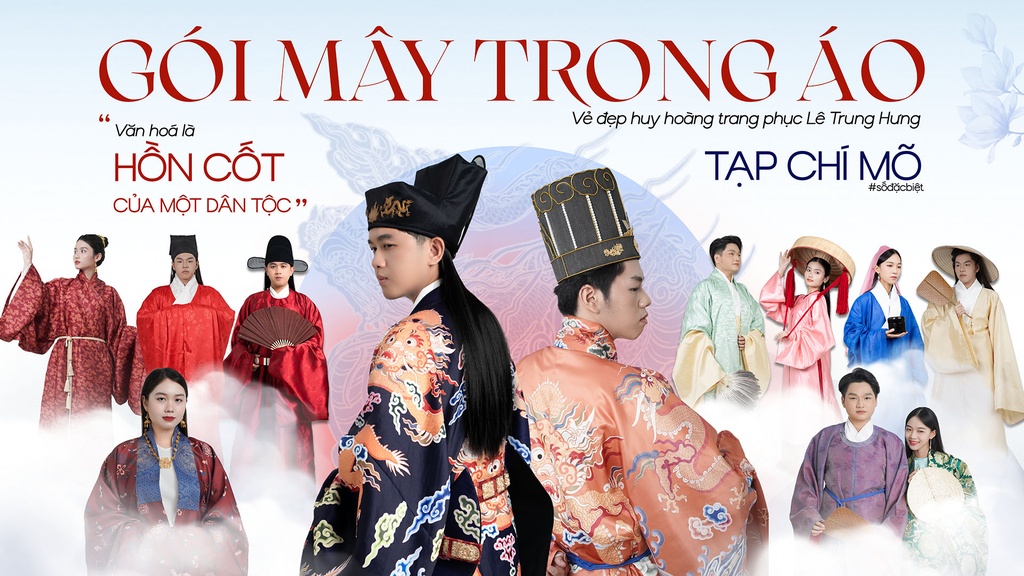để tặng cho tác giả tài liệu này


Đã đánh giá tài liệu
Cảm ơn bạn đã phản hồi

Tác giả: Phan Thị Ngọc Bích, Ngô Hương Giang, Nguyễn Hoàng Minh Ngọc, Phan Nguyễn Bách Thông, Đặng Nguyễn Thành Tín
Nhà cung cấp: Heritage Brand Review Award 2025
Ấn phẩm dự thi Heritage Brand Review Award - được sáng tác bởi nhóm thí sinh đến từ Đại học Văn Lang - tái hiện nhịp sống yên bình và chất quê dân dã của vùng đất Bến Tre qua từng khung hình. Mời Quý độc giả thưởng thức và góp ý!
INTRODUCTION
Ngọc - Voice-over
"Ben Tre, known as the ""Land of Coconut"", was formed during the southward expansion in the 17th century. Located in the coastal region of the Mekong Delta, Ben Tre features a distinctive landscape of low and flat plains, bordered by three major rivers — the Tien River, the Ham Luong River, the Co Chien River — and the East Sea, with a 65-kilometer coastline. Shaped like a fan, Ben Tre shares borders with Tien Giang and Vinh Long provinces, and enjoys a tropical monsoon climate with two distinct seasons: the rainy season and the dry season.
The location at the end of the Mekong River gives Ben Tre a unique riverine landscape, a rich ecosystem, and significant potential for agricultural development, tourism, and waterway transportation."
STOP 1: DONG KHOI HISTORICAL SITE – THE SPIRIT OF UPRISING
Tín (walking mid-frame):
The Dong Khoi Historical Site in Ben Tre is located in Dinh Thuy commune, Mo Cay Nam district. It is the place where the Southern Dong Khoi movement began in 1960. The site was recognized as a National Historical Site in 1993.
Tín - Voice-over:
Currently, the Dong Khoi Historic Site is established as a place to display historical images of the heroic victories of our people and military in the two wars of independence. It also serves as a venue for educating future generations about revolutionary traditions and facilitates tourism activities for those interested in learning about the Dong Khoi event in Ben Tre.
A prominent feature at the Dong Khoi Historic Site is a 3-meter-high granite victory stele, inscribed with the phrase "Brave Dong Khoi, Defeating the Americans and the Nguy", which serves as a reminder of the nation's heroic spirit.
The traditional house, symbolized by a 12-meter-high torch, vividly depicts the revolutionary movement and the Dong Khoi uprising. It showcases representative artifacts such as coconut shells, machetes, and homemade bombs, symbols of the indomitable will to fight. The site is not only a historical symbol but also a place to honor the unwavering spirit and educate future generations about revolutionary traditions, contributing to the glory of the heroic land of Ben Tre.
STOP 2: HUYNH PHU ANCIENT HOUSE – WHISPERS OF TIME
Giang (smiling in front of the house):
The Huynh Phu ancient house is considered the oldest architectural work in Ben Tre. Despite being over 100 years old, the house still retains its distinctive cultural characteristics.
Ngọc - Voice-over
The Huynh Phu Ancient House was completed in 1904, showcasing the architectural style of Huế with its Xuyen Trinh structure and three-tiered foundation made of Chinese tiles. The house is built in a one-line shape, consisting of 3 main rooms and 2 small rooms at the ends, with a prominent area for worshiping Buddha and ancestors, as well as a spacious common living space.
The house is handcrafted with 48 columns made of lim and căm xe wood, and 32 columns made of cement. The system of rafters and tiled roof are intricately carved and painted with sophisticated cloud and water patterns.
A distinctive feature of the house is the pair of liễn made from solid wood trunks, hollowed out to fit tightly around the columns, with traditional carvings of themes such as the twenty- four filial piety and scenes of fishing, farming, and hunting. From the base of the columns to the wooden frame, carvings of familiar motifs like crabs, shrimp, kylin, and phoenixes are found. The ancestor altar is the pinnacle of craftsmanship, with carved wood, lacquered and gilded, showcasing an understated elegance. The bedroom remains well-preserved with two lim wood beds placed opposite each other."
STOP 3: NGHINH ONG NAM HAI FESTIVAL – CALL OF THE SEA
Ngọc - Voice-over
The Nghinh Ong Nam Hai Festival is a traditional festival of the people of Ben Tre, with the custom of worshiping the Ong fish to express gratitude towards this sacred creature, hoping for protection in times of danger and praying for calm seas and good catches. The festival has been recognized as a national intangible cultural heritage, a great pride of the people of Ben Tre, especially the coastal fishermen.
The Nghinh Ong Festival in Binh Thang commune, Binh Dai district, is considered the largest and most typical Nghinh Ong festival in Ben Tre. The festival is usually held on the 15th and 16th of the 6th lunar month. The Ong fish shrine is located in the Chai village, built and inaugurated in 1951 with a traditional three-room architecture facing east.
A special feature of the festival is the ceremonies held on the sea, including many solemn rituals such as the Tuc Yet Ceremony, the Nghinh Ong Ceremony, the Chanh Te Ceremony, and the Dai Boi Offering Ceremony; among these, the Nghinh Ong Ceremony is the most important. After the ceremonies, the festival becomes lively with folk games such as tug-of-war, lion dancing, and other activities. Visitors can experience the warmth and hospitality of the locals and immerse themselves in the lively atmosphere of the festival.
Today, the Nghinh Ong Festival is a cultural beauty that reflects the distinctive identity of coastal fishermen, with a strong influence that attracts participation from local fishermen as well as tourists. It also contributes to enriching and diversifying the festival activities in the Coconut Land.
STOP 4: SON DOC RICE PAPER VILLAGE – FLAVORS OF HERITAGE
Bích:
Welcome to Son Doc rice paper village
Ngọc - Voice-over
The Son Đoc rice crackers village in Hung Nhuong Commune, Giong Trom District, is renowned for its more than 100-year history and was recognized as a national intangible cultural heritage in twenty eighteen. Currently, the village has fifty one production facilities, twenty six of which specialize in making fried banana rice crackers. Using main ingredients such as glutinous rice, coconut milk, cassava, milk, sugar, and sesame, Son Đoc rice crackers retain their distinctive traditional flavor. In the last six months of 2022, local facilities produced 20 million crackers, generating over 20 billion VND in revenue, with products widely consumed both domestically and internationally. The village has three key cooperative households whose rice paper products have been recognized under the OCOP program. Efforts are underway to improve labeling and packaging to expand market reach.
STOP 5: THANH LONG COCONUT CANDY FACTORY – SWEET SOUL OF BEN TRE
Thông:
Coconut candy originated from Mo Cay District, Ben Tre Province, in the 18th century, with the main ingredients being coconut, sugar, and malt. Initially, coconut candy was made by hand as a gift for holidays and Tet. However, since the 1970s, production has expanded on a larger scale, becoming a famous specialty and a National Intangible Cultural Heritage.
Thông - Voice-over:
The Thanh Long coconut candy factory was founded in 1970 by Mrs. Nguyen Thi Vinh, a daughter of Ben Tre, marking a turning point for this humble local gift to reach far and wide. From the first handmade batches, she utilized the abundant coconut resources to create a sweet, rich flavor that is tightly woven into every piece of candy.
Later, the Thanh Long coconut candy factory was taken over by Mr. Nguyen Van Tao, who expanded it significantly. With a commitment to maintaining quality and reputation, he improved production technology, invested in modern machinery, and diversified the product range. Each piece of coconut candy is a blend of nature, skilled hands, and the genuine soul of the Coconut Land, spreading the flavor of the homeland across the country and the world.
FINAL SCENES: A FAREWELL FROM THE COCONUT LAND
Scene: Day at Rach Mieu Bridge
Ben Tre, the beloved land of the Coconut Region, is not only a place but also a treasure trove of rich culture and history. Its heritage is not just encapsulated in architectural landmarks but is also vibrantly present in traditional festivals, historical sites, and even in the local cuisine that reflects the essence of the homeland. Preserving and promoting these values is not only the responsibility of individuals or organizations but of the entire community, to not only safeguard the past but also open up opportunities for creativity and contribute to sustainable economic and social development.
Tài liệu liên quan

 11
11
Kim cương
Rating
Lượt xem


Ý kiến (0)